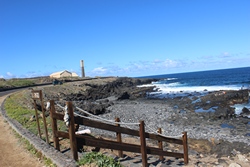
The coast of the municipality of Los Silos in the Northwest of the island of Tenerife is one of the most unknown by tourists, visitors and residents on the island.
From the old town of Los Silos, with its cobbled central street, we drive to Buena Vista del Norte and turn right at the first sign that shows us the way to the pools of the town of Los Silos. Once we reach the proximity of the coast, at the height of the Puerto de los Silos, we park the car and start our journey on foot along the Sibora Beach.
The walk along the Siboras shows us to the left the splendor of the Atlantic Ocean beating on the black pebbles of the beach and to the right the confines of the large banana plantations that characterize this town of indisputable agricultural vocation.
But also, from the beginning of the beach, one can see a small hut called "the house of the telegraph", and beyond, in the middle of the “Cape del Risco de Daute”, the chimney and the stores of what was the last sugar mill of the island, the sugar refining factory that between 1889 and 1890 erected the Manchester society of Lathbury & Company.
The history of the Lathbury & Company is at least curious, as it is the last gasp of sugarcane cultivation on the island of Tenerife, a crop which was the base of the island's prosperity and exports for much of the S. XVI and that in the XIX the century just occupied a marginal surface of the land. Even so, the British formed the “Ycod & Daute Estate Company Limited” and planted in the immediate vicinity of factory large extensions of sugar cane, the banana definitively replaced the sweet cane after the Great War.
Nevertheless, the remains of the factory popularly known by "La Torre"(The Tower) and whose machinery eventually moved to Portugal, is currently dedicated to storing bananas. Of the old industrial installation stands out the characteristic trunk-pyramidal chimney made in millstone stone in its lower two thirds and in yellow “tosca” in its upper third.
Following the evocative pattern of the old factory, we continue walking along this coast of ever-present seascape, sighting the innumerable puddles of sea water formed on the lava formations that enter into the ocean, silent witnesses of what was once a local industry of salt extraction.
Sea water ponds, “cardones” (Canarian Catus), and “tarajales” (Coast Trees) lead us to the Caleta de Interián, a quiet village with small houses, named after the fantastic cove where its beach lies, presided by the S. XVII Church of San Andrés (Saint Andrew), what makes the end of our journey.






 OurTenerife | February 1, 2017
OurTenerife | February 1, 2017  Accountancy
Accountancy  Legal Services
Legal Services  Web development
Web development